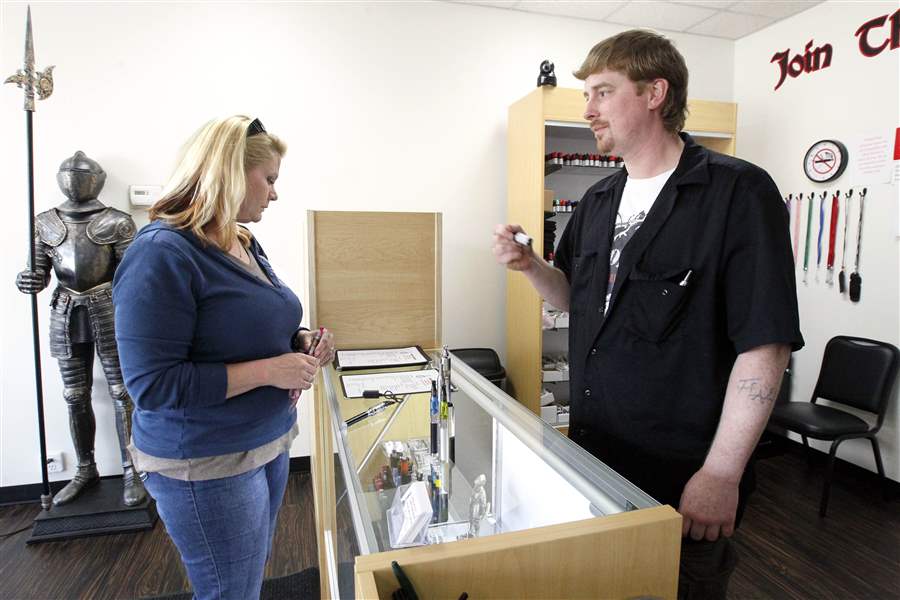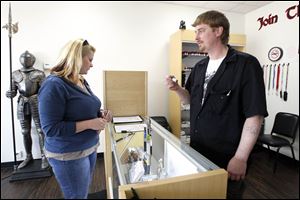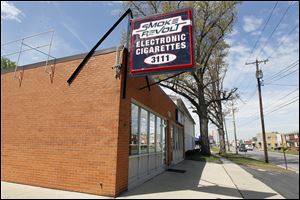
Vapor tales: Advocates say e-cigarettes help them quit
Health officials aren’t so sure about testimonies
5/13/2013
Josh Harris, owner of Smoke Revolt , right, sells flavored e-liquid nicotine to customer Michelle Mikesell, at his shop.
The Blade/Amy E. Voigt
Buy This Image

Josh Harris, owner of Smoke Revolt , right, sells flavored e-liquid nicotine to customer Michelle Mikesell, at his shop.
When doctors informed Josh Harris, that he had to quit smoking or he’d continue to be plagued with upper respiratory infections, the Toledo man immediately started looking for a substitute.
Not yet ready to completely give up smoking, Mr. Harris opted for what he calls a “clean” alternative: e-cigarettes.
“You’re not getting smoke, tar, or any of the other 400 chemicals in [tobacco] cigarettes,” Mr. Harris said. “The ingredients are right on the bottle with this — food preservatives, flavoring, and nicotine. You don’t know what you’re getting with [tobacco] cigarettes.”
Electronic cigarettes have been gaining popularity since emerging on the marketplace several years ago. Studies have documented the increase in users over the years. In a recent report, the Centers for Disease Control and Prevention found about 21 percent of adult smokers had used electronic cigarettes, up from 10 percent of smokers in 2010. Overall, about 6 percent of adults have tried e-cigarettes, according to the CDCP.
Electronic cigarettes — also called e-cigarettes and personal vaporizers — are battery-powered devices and often look like traditional cigarettes and cigars or pens or other mechanical devices. An electrical coil inside the device heats a liquid nicotine solution in a disposable cartridge, creating a vapor that is then inhaled by the user.
Fruity flavors such as strawberry, cherry vanilla, chocolate, and others, including tobacco, can be added to the cartridges, which come in various strengths.
Twenty-four milligrams is the equivalent to two packs a day of tobacco cigarettes and 18 milligrams equals about a pack a day. When a user activates the e-cigarette, he or she receives a dose of nicotine, which can be spread out for however the person wants it to last.
Fans of e-cigarettes argue that the new cigarettes are better for their health and aid in the quitting process.
“It’s better than cigarettes because it doesn’t have the cancer causing chemicals,” said Vanessa Kish, manager of the 21 Century Smoking kiosk at Westfield Franklin Park mall. “We have COPD and cancer patients, nurses, and doctors that smoke it because of that.”

Smoke Revolt is located at 3111 W. Sylvania Ave.
After smoking a pack a day for 20 years, Mr. Harris, the owner of Smoke Revolt, an e-cigarette store and cafe on Sylvania Avenue in Toledo, quit smoking tobacco cigarettes immediately after he started using e-cigarettes three years ago. He uses a 12-milligram cartridge, which is slightly less than one pack of tobacco cigarettes.
“Some people use them to quit smoking altogether. They lower the cartridge strength, until eventually they’re down to nothing,” Mr. Harris said. “We’ve got customers that have tried everything — the gum, the patch, hypnosis, acupuncture — and it doesn’t work, but they can stick with this because it’s so easy.”
Rachael Jeffries, 26, of Lambertville visited the shop recently for a new nicotine cartridge. She got her first electronic cigarette in December after smoking traditional cigarettes for 10 years.
“I have a 3-year-old son and I didn’t want him to be affected by my smoking,” Ms. Jeffries said.
Electronic cigarettes are not regulated and can be used inside public spaces. E-cigarettes are also less expensive than traditional cigarettes, Mr. Harris said.
“A lot of people are switching just to save the money,” said Mr. Harris, who serves more than 600 customers a month at his shop. “If a couple were spending $80 to $90 a month on [tobacco] cigarettes, they can do [e-cigarettes] for $20 to $25 a month.”
Health officials argue the long-term effects of the unregulated products are unknown and require more research.
“There are fewer chemicals in e-cigarettes and no carbon dioxide is emitted. Those certainly would be a reduction in harmful inhalants,” said Holly Kowalczk, a registered respiratory therapist at Promedica St. Luke’s Hospital. “However, some of the brands still contain harmful chemicals, such as diethylene glycol, which is used in antifreeze.”
Ms. Kowalczk, who also is a certified tobacco treatment specialist, said it's unlikely that using e-cigarettes as a means to quit smoking will cure a smoking addiction.
“Nicotine addiction has always been the problem. People trying to use e-cigarettes aren’t really addressing that issue,” Ms. Kowalczk said.
“They’re still putting nicotine in their bodies and they’re still engaging in smoking behaviors.”
Contact RoNeisha Mullen at: rmullen@theblade.com or 419-724-6133.